人教版(2019)必修 第二册Unit 4 History and traditions Reading and Thinking课件(共36张PPT,内镶嵌视频)
文档属性
| 名称 | 人教版(2019)必修 第二册Unit 4 History and traditions Reading and Thinking课件(共36张PPT,内镶嵌视频) | 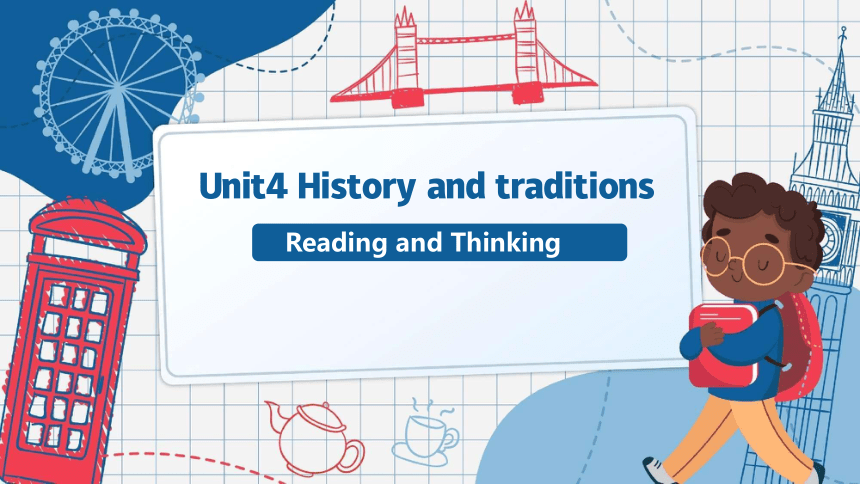 | |
| 格式 | pptx | ||
| 文件大小 | 27.9MB | ||
| 资源类型 | 教案 | ||
| 版本资源 | 人教版(2019) | ||
| 科目 | 英语 | ||
| 更新时间 | 2023-06-01 22:22:31 | ||
图片预览

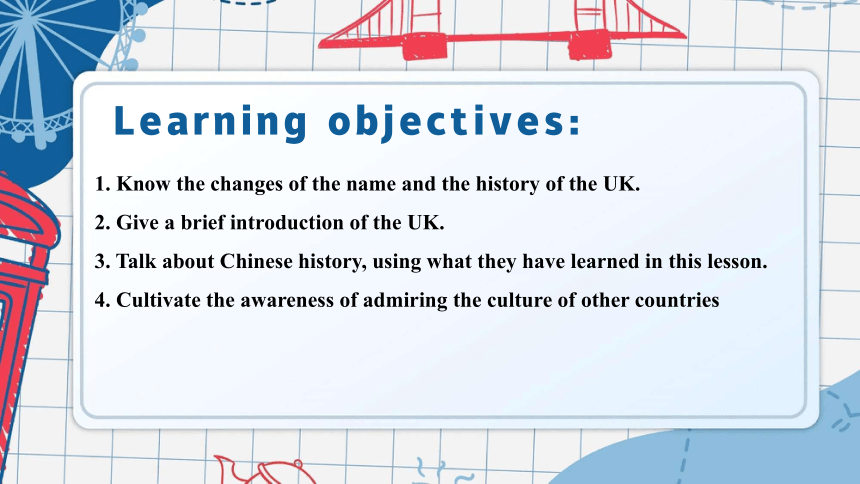

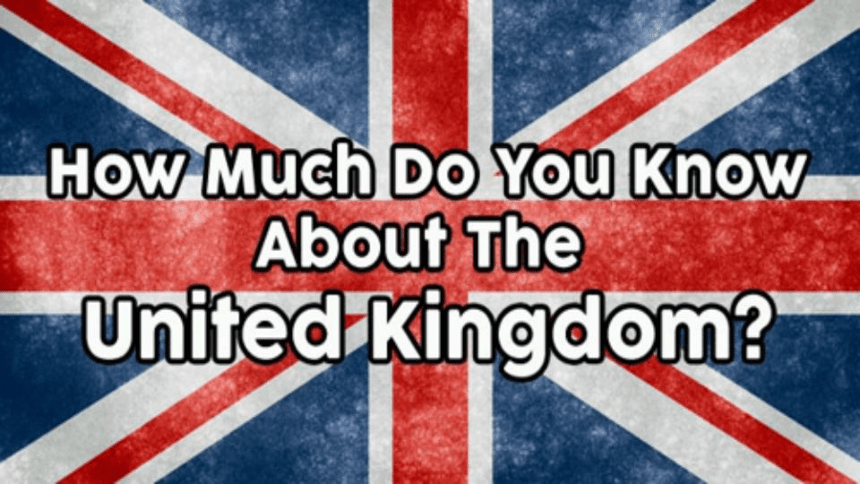
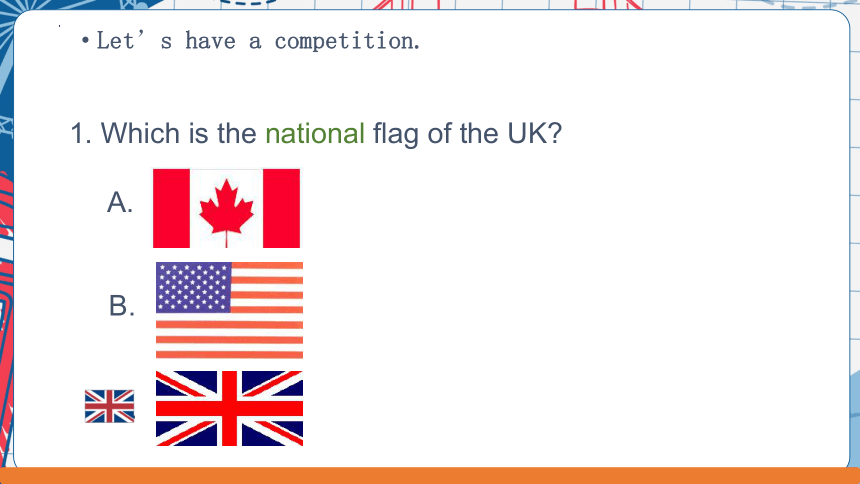
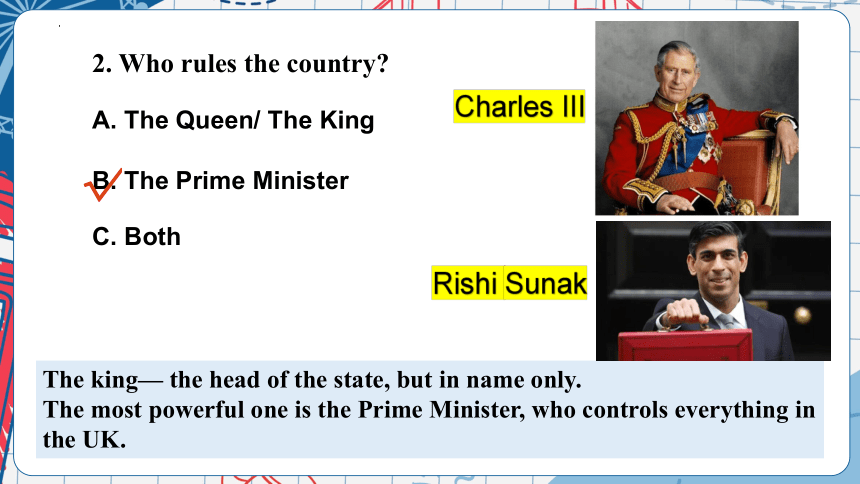
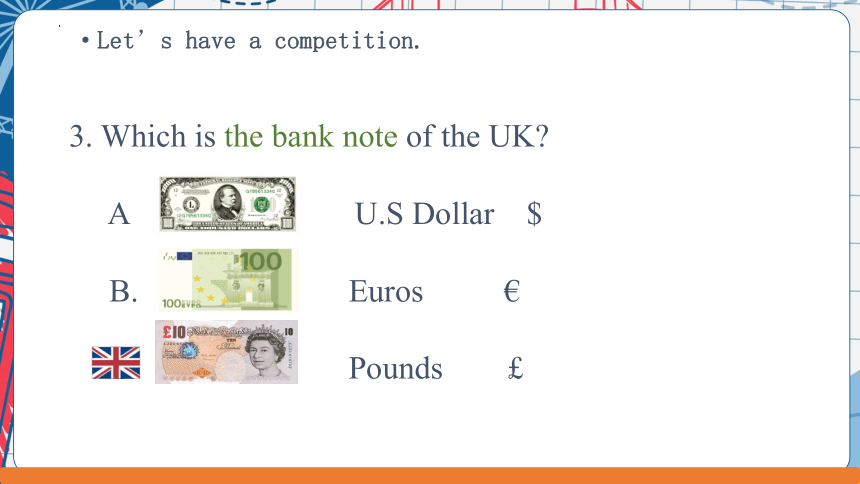
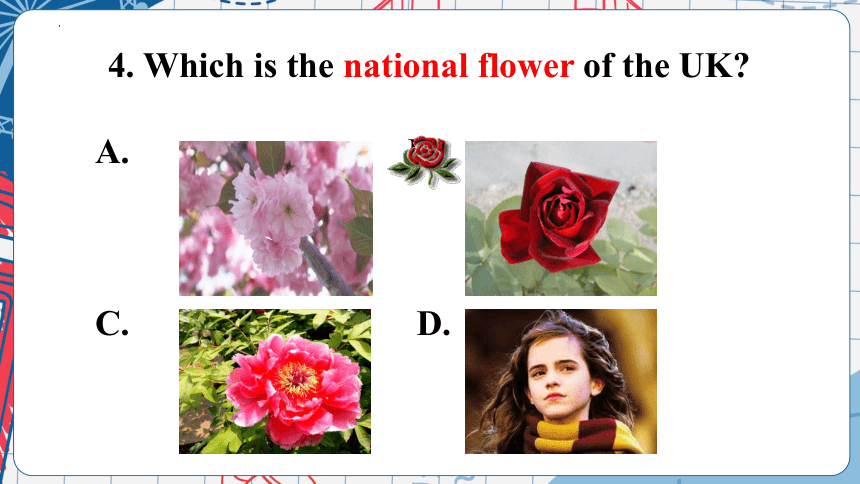
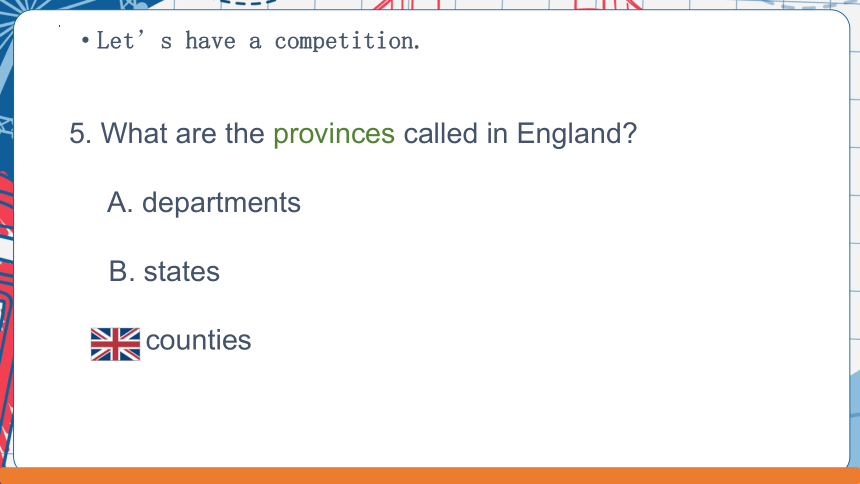
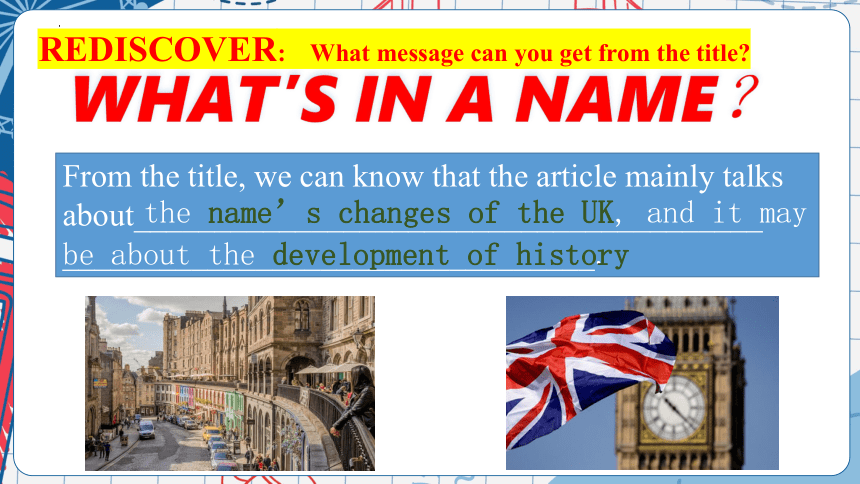
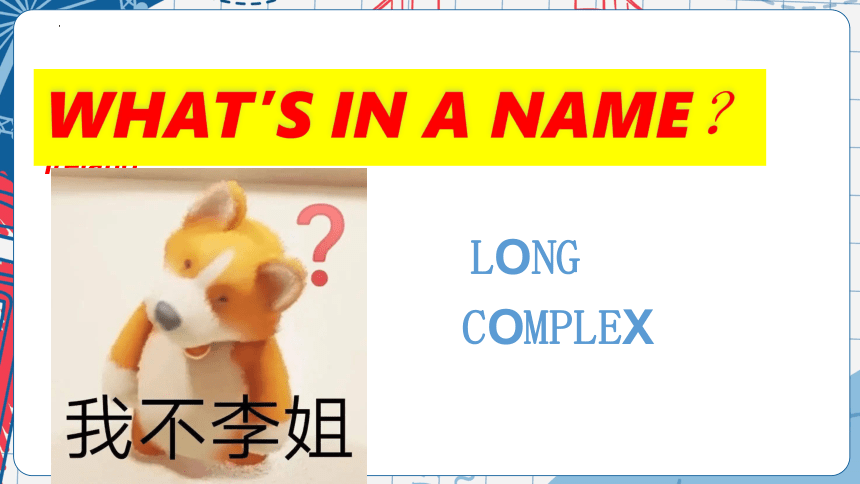
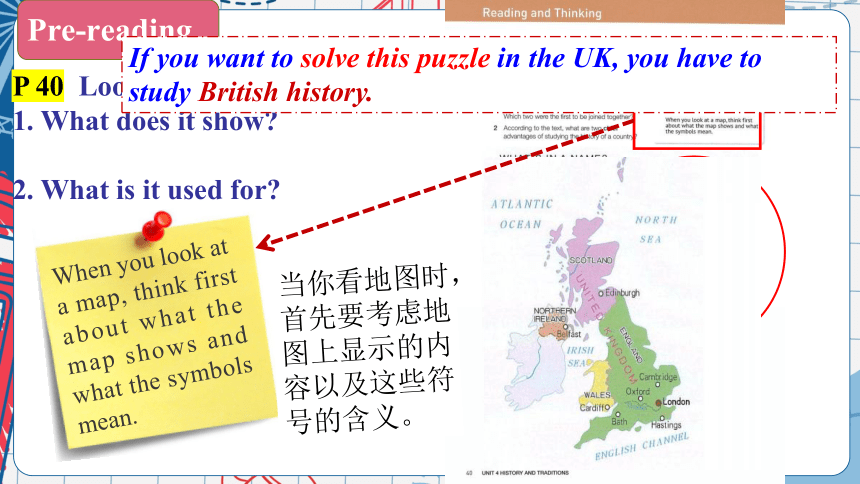
文档简介
(共36张PPT)
Unit4 History and traditions
Reading and Thinking
Learning objectives:
1. Know the changes of the name and the history of the UK.
2. Give a brief introduction of the UK.
3. Talk about Chinese history, using what they have learned in this lesson.
4. Cultivate the awareness of admiring the culture of other countries
Let’s have a competition.
1. Which is the national flag of the UK
A.
B.
C.
2. Who rules the country
A. The Queen/ The King
B. The Prime Minister
C. Both
Rishi Sunak
The king— the head of the state, but in name only.
The most powerful one is the Prime Minister, who controls everything in the UK.
Charles III
√
Let’s have a competition.
3. Which is the bank note of the UK
A U.S Dollar $
B. Euros ?
C. Pounds
4. Which is the national flower of the UK
A. B.
C. D.
Let’s have a competition.
5. What are the provinces called in England
A. departments
B. states
C. counties
From the title, we can know that the article mainly talks about_______________________________________
_________________________________.
the name’s changes of the UK, and it may
be about the development of history
WHAT’S IN A NAME?
REDISCOVER: What message can you get from the title
What’s the full name of YINGGUO
The United Kingdom of Great Britain and Northern Ireland
LONG
COMPLEX
WHAT’S IN A NAME?
P 40 Look at the map.
1. What does it show
2. What is it used for
When you look at a map, think first about what the map shows and what the symbols mean.
当你看地图时,首先要考虑地图上显示的内容以及这些符号的含义。
Pre-reading
If you want to solve this puzzle in the UK, you have to study British history.
An administrative zoning map 行政区划图
A traffic map 交通图
A weather map 气象图
A resource map 资源图
What is the type of the map
√
Pre-reading
2.What’s the main idea of the passage
A. The history of the United Kingdom.
B. The geography of the United Kingdom.
C. The people of the United Kingdom.
D. The politics of the United Kingdom.
√
Fast-reading
1.What is the genre(语篇类型) of the text
A. Narration B. Argumentation C. Exposition
(叙述文) (议论文) (说明文)
Para. 1
Para. 2
Para. 3
Para. 4
Para. 5
A. The origin of the name of the UK.
B. The influences of the four groups of
invaders.
C. The significance of studying the
British history.
D. The similarities and differences of the
four countries.
E. The introduction to the topic.
Match the paragraph with its main idea
Carful reading
part3
Careful-reading
Q1: How many names are used to refer to the UK and what are they?
Para.1 A puzzle
Q3: How did UK come into being
Para.2
The origin of its name
the
Kingdom
of
England
How did UK come into being
Wales
How did UK come into being
16th century
Scotland
18th century
the Kingdom of Great Britain
How did UK come into being
19th century
the United Kingdom of Great Britain and Ireland
Ireland
How did UK come into being
20th century
Northern
Ireland
the United Kingdom of Great Britain and Northern Ireland
=
England
Scotland
Ireland
the UK
How did UK come into being
England
+Wales
England+Wales
+Scotland
(Great Britain)
Great Britain
+ Northern Ireland
Great Britain
+Ireland
in the 16th century
in the 18th century
in the 19th century
be joined to
be joined to
be added to
How did the UK come into being
in the 20th century
break away from
+
+
=
Do the four countries work together in all areas
the UK
Similarities
Differences
flag
currency
military defence
education system
legal system
traditions
football teams
Para.3
The United Kingdom has a long and interesting history to explore, which can help you understand much more about the country and its traditions. Almost everywhere you go in the UK, you will be surrounded by evidence of four different groups of people who took over at different times throughout history. The first group, the Romans, came in the first century. Some of their great achievements included building towns and roads. Next, the Anglo-Saxons arrived in the fifth century. They introduced the beginnings of the English language, and changed the way people built houses.The Vikings came in the eighth century, left behind lots of new vocabulary, and also the names of many locations across the UK. The last group were the Normans. They conquered England after the well-konwn Battle of Hastings in the 11th century. They had castles built all around England, and made changes to the legal system. The Normans were French, so many French words slowly entered into the English language.
Para4:
Para4:What did the four groups bring to the UK
in the 1st century
in the 5th century
in the 8th century
the Anglo-Saxons
the Romans
the Vikings
in the 11th century
the Normans
Para.4 People and traditions
towns and roads
language and houses
vocabulary and
names of locations
castles, legal system and French words
Who came
When
What changed
Q5: Is there anything else we can benefit from studying the history of the UK
Para.5 More information
Try to draw a mind map of according to the whole passage.
1st century
5th century
8th century
11th century
16th century
18th century
19th century
20th century
the Anglo-Saxons
the Vikings
the Vikings
What’s in a name
In a name, there is a _________.
English language
British culture
Further Thinking
history
culture & traditions
politics
geography
civilization
…
Is it important for a people (民族) to know their history and traditions Why
a person
a people
National Responsibility
国家责任
National Cohesion/ko hi n/
民族凝聚力
National Confidence
民族自信心
Discussion
A people without the knowledge of their past history, origin and culture is like a tree without roots.
—Marcus Garvey
一个不了解自己历史、起源和文化的民族,就如同一棵无根之树。
The United Kingdom, Great Britain, Britain, England — many people are confused by 1._____ these different names mean. In the 16th century, the nearby country of Wales 2._________ (join) to the Kingdom of England. In the 19th century, the Kingdom of Ireland was added to create the United Kingdom of Great Britain and Ireland. Finally, the southern part of Ireland 3.______ (break) away from the UK, which resulted in the full name today. However, most people just use the 4._________ (shorten) name: the UK.
The four countries 5.____ belong to the United Kingdom work together in some areas. There were four sets of invaders and the last group were the Normans. They had castles 6._____ (build) all around England and made changes 7.__ the legal system. Studying the history of the country will make your visit much more 8.________ (enjoy). The capital city London is 9.___ ancient port city that has a history 10.______ (date) back to Roman times.
what
was joined
broke
shortened
课文语法填空
that
built
to
enjoyable
an
dating
After-reading
Complete the conversation about the UK using the phrases in their correct forms.
A: I can never remember what the UK means! There’s England, Britain, _____________ Great Britain!
B: Well, it helps if you remember that there are four countries that ____________ the UK. That’s why it’s called the United Kingdom.
A: Four countries I must have been asleep in that part of our history class! So the first country was England, and the others were ___________ that
B: Yes, right. First England, then Wales, then Scotland. The last country was Ireland, but later the southern half didn’t want to be ___________ the United Kingdom.
A: Oh, I remember now! The southern part ______________ from Northern Ireland, right
B: Yes, you got it well remembered! But ___________________ in history class next time!
as well as belong to add to join to break away keep your eyes open
as well as
belong to
joined to
added to
broke away
keep your eyes open
Thank you for your attention!
Unit4 History and traditions
Reading and Thinking
Learning objectives:
1. Know the changes of the name and the history of the UK.
2. Give a brief introduction of the UK.
3. Talk about Chinese history, using what they have learned in this lesson.
4. Cultivate the awareness of admiring the culture of other countries
Let’s have a competition.
1. Which is the national flag of the UK
A.
B.
C.
2. Who rules the country
A. The Queen/ The King
B. The Prime Minister
C. Both
Rishi Sunak
The king— the head of the state, but in name only.
The most powerful one is the Prime Minister, who controls everything in the UK.
Charles III
√
Let’s have a competition.
3. Which is the bank note of the UK
A U.S Dollar $
B. Euros ?
C. Pounds
4. Which is the national flower of the UK
A. B.
C. D.
Let’s have a competition.
5. What are the provinces called in England
A. departments
B. states
C. counties
From the title, we can know that the article mainly talks about_______________________________________
_________________________________.
the name’s changes of the UK, and it may
be about the development of history
WHAT’S IN A NAME?
REDISCOVER: What message can you get from the title
What’s the full name of YINGGUO
The United Kingdom of Great Britain and Northern Ireland
LONG
COMPLEX
WHAT’S IN A NAME?
P 40 Look at the map.
1. What does it show
2. What is it used for
When you look at a map, think first about what the map shows and what the symbols mean.
当你看地图时,首先要考虑地图上显示的内容以及这些符号的含义。
Pre-reading
If you want to solve this puzzle in the UK, you have to study British history.
An administrative zoning map 行政区划图
A traffic map 交通图
A weather map 气象图
A resource map 资源图
What is the type of the map
√
Pre-reading
2.What’s the main idea of the passage
A. The history of the United Kingdom.
B. The geography of the United Kingdom.
C. The people of the United Kingdom.
D. The politics of the United Kingdom.
√
Fast-reading
1.What is the genre(语篇类型) of the text
A. Narration B. Argumentation C. Exposition
(叙述文) (议论文) (说明文)
Para. 1
Para. 2
Para. 3
Para. 4
Para. 5
A. The origin of the name of the UK.
B. The influences of the four groups of
invaders.
C. The significance of studying the
British history.
D. The similarities and differences of the
four countries.
E. The introduction to the topic.
Match the paragraph with its main idea
Carful reading
part3
Careful-reading
Q1: How many names are used to refer to the UK and what are they?
Para.1 A puzzle
Q3: How did UK come into being
Para.2
The origin of its name
the
Kingdom
of
England
How did UK come into being
Wales
How did UK come into being
16th century
Scotland
18th century
the Kingdom of Great Britain
How did UK come into being
19th century
the United Kingdom of Great Britain and Ireland
Ireland
How did UK come into being
20th century
Northern
Ireland
the United Kingdom of Great Britain and Northern Ireland
=
England
Scotland
Ireland
the UK
How did UK come into being
England
+Wales
England+Wales
+Scotland
(Great Britain)
Great Britain
+ Northern Ireland
Great Britain
+Ireland
in the 16th century
in the 18th century
in the 19th century
be joined to
be joined to
be added to
How did the UK come into being
in the 20th century
break away from
+
+
=
Do the four countries work together in all areas
the UK
Similarities
Differences
flag
currency
military defence
education system
legal system
traditions
football teams
Para.3
The United Kingdom has a long and interesting history to explore, which can help you understand much more about the country and its traditions. Almost everywhere you go in the UK, you will be surrounded by evidence of four different groups of people who took over at different times throughout history. The first group, the Romans, came in the first century. Some of their great achievements included building towns and roads. Next, the Anglo-Saxons arrived in the fifth century. They introduced the beginnings of the English language, and changed the way people built houses.The Vikings came in the eighth century, left behind lots of new vocabulary, and also the names of many locations across the UK. The last group were the Normans. They conquered England after the well-konwn Battle of Hastings in the 11th century. They had castles built all around England, and made changes to the legal system. The Normans were French, so many French words slowly entered into the English language.
Para4:
Para4:What did the four groups bring to the UK
in the 1st century
in the 5th century
in the 8th century
the Anglo-Saxons
the Romans
the Vikings
in the 11th century
the Normans
Para.4 People and traditions
towns and roads
language and houses
vocabulary and
names of locations
castles, legal system and French words
Who came
When
What changed
Q5: Is there anything else we can benefit from studying the history of the UK
Para.5 More information
Try to draw a mind map of according to the whole passage.
1st century
5th century
8th century
11th century
16th century
18th century
19th century
20th century
the Anglo-Saxons
the Vikings
the Vikings
What’s in a name
In a name, there is a _________.
English language
British culture
Further Thinking
history
culture & traditions
politics
geography
civilization
…
Is it important for a people (民族) to know their history and traditions Why
a person
a people
National Responsibility
国家责任
National Cohesion/ko hi n/
民族凝聚力
National Confidence
民族自信心
Discussion
A people without the knowledge of their past history, origin and culture is like a tree without roots.
—Marcus Garvey
一个不了解自己历史、起源和文化的民族,就如同一棵无根之树。
The United Kingdom, Great Britain, Britain, England — many people are confused by 1._____ these different names mean. In the 16th century, the nearby country of Wales 2._________ (join) to the Kingdom of England. In the 19th century, the Kingdom of Ireland was added to create the United Kingdom of Great Britain and Ireland. Finally, the southern part of Ireland 3.______ (break) away from the UK, which resulted in the full name today. However, most people just use the 4._________ (shorten) name: the UK.
The four countries 5.____ belong to the United Kingdom work together in some areas. There were four sets of invaders and the last group were the Normans. They had castles 6._____ (build) all around England and made changes 7.__ the legal system. Studying the history of the country will make your visit much more 8.________ (enjoy). The capital city London is 9.___ ancient port city that has a history 10.______ (date) back to Roman times.
what
was joined
broke
shortened
课文语法填空
that
built
to
enjoyable
an
dating
After-reading
Complete the conversation about the UK using the phrases in their correct forms.
A: I can never remember what the UK means! There’s England, Britain, _____________ Great Britain!
B: Well, it helps if you remember that there are four countries that ____________ the UK. That’s why it’s called the United Kingdom.
A: Four countries I must have been asleep in that part of our history class! So the first country was England, and the others were ___________ that
B: Yes, right. First England, then Wales, then Scotland. The last country was Ireland, but later the southern half didn’t want to be ___________ the United Kingdom.
A: Oh, I remember now! The southern part ______________ from Northern Ireland, right
B: Yes, you got it well remembered! But ___________________ in history class next time!
as well as belong to add to join to break away keep your eyes open
as well as
belong to
joined to
added to
broke away
keep your eyes open
Thank you for your attention!
